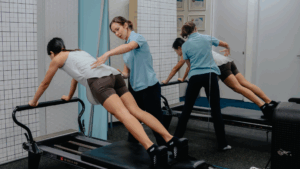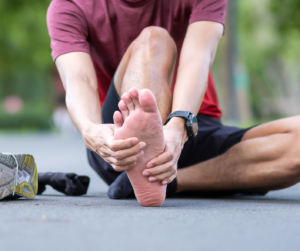What is scoliosis?
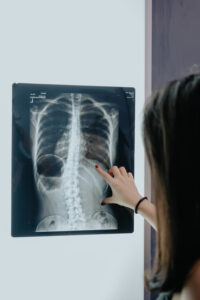
Scoliosis is a condition where the spine curves abnormally, resembling an “S” or “C” shape. This curvature can affect people of all ages, but it is most commonly diagnosed during adolescence. Understanding the basics of scoliosis is crucial for identifying the need for intervention.
What are the common causes of scoliosis in children?
While the exact cause of scoliosis remains unknown in many cases, there are several common factors that contribute, particularly in children. Genetics, muscle imbalances, and neuromuscular conditions can play a role in the development of scoliosis. Recognising these factors is essential for early detection and intervention.
How do you know if you have scoliosis?
Spotting scoliosis early is key to effective management. Keep an eye out for signs such as uneven shoulders, an asymmetrical waist, or leaning to one side. Regular check-ups with a healthcare professional, especially during growth spurts, can aid in early detection.
What are the signs of scoliosis?
Uneven shoulder level
- This can be indicated by your t-shirt slipping to one side.
- Noticeable imbalance in shoulder height, suggesting potential spinal curvature.
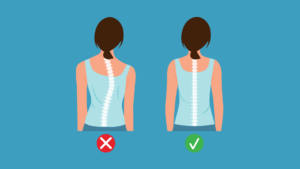
Uneven hip level
- Pants or skirts riding up higher on one side.
- Asymmetry in the hip level, indicating a possible tilt in the pelvic region.
Body leaning to one side
- Observable leaning or tilting of the body.
- A noticeable shift in the body’s alignment, possibly revealing the presence of scoliosis.
Greater space between one arm and body on one side
- An unusual gap between the arm and torso, potentially linked to spinal curvature.
Head not centered
- Head appearing off-center.
- The head not aligning with the centre of the body, suggesting a deviation from the natural spinal position.
Recognising these signs early on can prompt timely intervention and facilitate a more effective approach to managing scoliosis. If you or someone you know exhibits these indicators, seeking professional assessment is essential for a comprehensive understanding of the condition and the development of a suitable management plan.
If you present with some of the signs listed above, we strongly recommend heading for a check-up.
What can scoliosis lead to?
Beyond the noticeable changes in appearance associated with scoliosis, the more concerning implications arise when the condition is left unaddressed, particularly in cases of moderate to severe curvature. One of the primary risks involves the rib cage exerting pressure on internal organs, leading to various complications. These potential complications can result in:
Persistent back pain
- Untreated scoliosis can result in persistent back pain, impacting an individual’s daily life and overall well-being. The misalignment of the spine contributes to ongoing discomfort and reduced quality of life.
Damage to heart and lungs
- The curvature of the spine in scoliosis can affect the positioning and functioning of the rib cage, potentially causing compression on the heart and lungs. Over time, this pressure may lead to damage and compromise cardiovascular and respiratory health.
Breathing problems
- As the rib cage presses against the lungs, breathing difficulties may arise. Restricted lung capacity can lead to respiratory issues, affecting oxygen intake and potentially causing complications in severe cases.
Damage to nerves
- The abnormal curvature of the spine in scoliosis can exert pressure on surrounding nerves, resulting in damage. This can lead to neurological symptoms, including pain, numbness, or tingling sensations, further exacerbating the impact on daily life.
Understanding these potential consequences emphasises the importance of early detection and intervention in managing scoliosis. Timely physiotherapy and medical interventions can help mitigate the progression of the condition, alleviate symptoms, and prevent the development of severe complications. If you suspect scoliosis or have been diagnosed with it, seeking professional guidance and appropriate treatment is crucial to maintaining both spinal health and overall well-being.
What are the treatment methods for scoliosis?
Scoliosis, characterised by an abnormal curvature of the spine, necessitates various treatment approaches tailored to the individual’s condition. These methods aim to manage symptoms, prevent progression, and improve overall spinal health. Common treatment options include:
Physiotherapy for scoliosis

Physiotherapy is a cornerstone in scoliosis management. Tailored exercise plans, stretches, and strengthening routines are designed to address the curvature, enhance posture, and alleviate associated symptoms. Regular sessions with a physiotherapist contribute to improved mobility and reduced pain.
Bracing for scoliosis
In cases of moderate scoliosis, bracing may be recommended to impede further curvature progression, especially in adolescents with growing spines. Different types of braces are available, and their usage is determined by the severity and location of the curvature. However, it is important to note that bracing is not a cure for scoliosis, rather, it slows down the progression of the spinal curvature, primarily in growing adolescents.
Surgery for scoliosis
For severe cases or when other methods prove ineffective, surgical intervention may be considered. The goal of surgery is to straighten the spine, stabilise it, and prevent further progression. Surgical options include spinal fusion, where vertebrae are fused together, and instrumentation to support the spine.
Chiropractic care for scoliosis
Scoliosis, a progressive condition affecting the curvature of the spine, demands a proactive approach to treatment in order to impede its advancement. Chiropractic care emerges as a viable solution, emphasising physical adjustments aimed at rectifying spinal misalignments. Through consistent chiropractic adjustments, positive feedback has been observed from individuals undergoing care for scoliosis.
However, the effectiveness of this non-invasive and drug-free approach hinges on several factors, including the severity of the condition, the individual’s response to adjustments, and the stage of growth—whether the patient is a child or an adult. By staying ahead of the progression of scoliosis, chiropractic care not only provides relief from pain but also endeavours to prevent further deterioration of the spinal curvature.
If considering chiropractic care for scoliosis, do check out our sister brand Chiropractic Singapore for consultations.
Can physiotherapy help scoliosis?
Yes, physiotherapy is a valuable and non-invasive approach to managing scoliosis. By focusing on strengthening core muscles, improving flexibility, and correcting posture, physiotherapy aims to mitigate the progression of the curvature and enhance overall well-being.
What are the benefits of scoliosis physiotherapy?

Scoliosis physiotherapy, beyond solely addressing the spinal curvature, brings about a spectrum of advantages that significantly impact an individual’s well-being:
Enhanced posture:
One of the primary goals of scoliosis physiotherapy is to improve posture. Through targeted exercises and techniques, physiotherapy aims to correct spinal alignment, leading to a more balanced and upright posture. This not only contributes to a better appearance but also alleviates strain on the spine and surrounding muscles.
Pain reduction:
Scoliosis often accompanies discomfort or pain, particularly as the curvature progresses. Physiotherapy interventions, such as specific exercises and manual therapies, can help alleviate this pain. By strengthening supporting muscles and improving flexibility, physiotherapy minimises strain on the spine, consequently reducing associated pain levels.
Increased muscle strength:
Physiotherapy exercises focus not only on the spine but also on strengthening core muscles and those surrounding the affected area. This improved muscle strength provides better support for the spine, aiding in stabilisation and reducing the progression of the curvature.
Enhanced mobility and functionality:
Individuals with scoliosis may experience limitations in movement due to the curvature affecting their flexibility. Physiotherapy interventions target this aspect by incorporating exercises that enhance flexibility and mobility. This helps in restoring range of motion and overall functionality, allowing individuals to engage in daily activities with greater ease.
Improved quality of life:
Collectively, the benefits of scoliosis physiotherapy contribute to an improved quality of life for those managing the condition. Beyond the physical improvements, the reduction in pain, better posture, increased mobility, and enhanced strength empower individuals to lead more active, comfortable, and fulfilling lives.
Tailored approach:
What makes scoliosis physiotherapy particularly impactful is its personalised nature. Physiotherapists craft individualised treatment plans, considering the severity of the curvature, the patient’s age, lifestyle, and specific needs. This tailored approach ensures that the therapy addresses the unique challenges posed by scoliosis for each person.
What are some physiotherapy exercises for scoliosis?
When it comes to scoliosis physiotherapy, a personalised exercise plan is pivotal in addressing the curvature and promoting overall spinal health. Here’s a closer look at some specific physiotherapy exercises commonly incorporated into tailored treatment regimens:
Stretches
Chest opener stretch

-
- Stand or sit with arms extended, clasping hands behind your back.
- Gently lift your arms, opening the chest and stretching the front of the shoulders.
Cat-cow stretch:
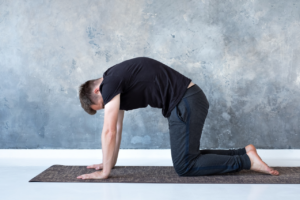

-
- Start on hands and knees, arching and rounding your back alternately.
- This dynamic movement stretches and mobilises the spine.
Strengthening exercises
Core strengthening:
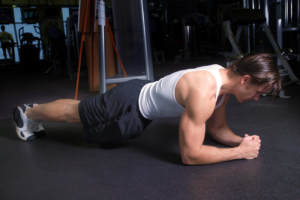
-
- Exercises like planks, side planks, and pelvic tilts are incorporated to target the core and stabilise the spine.
Lateral leg raises:

-
- Lie on one side and lift the top leg, engaging the lateral muscles.
- This exercise contributes to improved spinal stability.
Postural correction techniques
Mirror-assisted exercises:
-
- Perform various exercises in front of a mirror to ensure correct alignment and posture.
Bracing techniques:

-
- Depending on the severity of scoliosis, a physiotherapist may recommend specific braces to assist in maintaining correct posture.
Breathing exercises
Diaphragmatic breathing:
-
- Focus on deep, diaphragmatic breathing to engage the diaphragm and facilitate better control over the respiratory muscles.
Flexibility training
Hamstring stretch:

-
- Seated or standing, reach towards your toes, keeping the back straight. This stretch aids in maintaining optimal pelvic position.
It’s important to note that the effectiveness of these exercises lies in their integration into a comprehensive and personalised plan designed by a qualified physiotherapist. The therapist considers factors such as the degree of curvature, the patient’s overall health, and any existing musculoskeletal issues. Regular sessions and consistent adherence to the prescribed exercises contribute to positive outcomes in managing scoliosis through physiotherapy. Always consult with a healthcare professional before starting any new exercise regimen, especially for a condition as individualised as scoliosis.
How long does it take to see results with scoliosis physiotherapy?
The timeline for seeing results with scoliosis physiotherapy can vary based on factors such as the severity of the condition and the individual’s commitment to the exercise regimen. Consistency is key, and most patients experience gradual improvement over several months.
Embracing the straight path: Navigating scoliosis with physiotherapy excellence
Scoliosis physiotherapy offers a holistic and patient-centric approach to managing this spinal condition. By combining targeted exercises with a thorough understanding of the individual’s needs, physiotherapists play a crucial role in enhancing the lives of those affected by scoliosis. If you or someone you know is dealing with scoliosis, consider consulting with a qualified physiotherapist to embark on a journey towards a straighter, healthier spine.
FAQs
What are the management options for someone with severe curved spine scoliosis?
For individuals with severe curved spine scoliosis, options may include bracing or surgical intervention. A multidisciplinary approach involving orthopaedic specialists, physiotherapists, and other healthcare professionals is often recommended to determine the most suitable course of action.
Can scoliosis physiotherapy improve posture?
Absolutely. Scoliosis physiotherapy focuses on strengthening muscles and promoting proper alignment, which, in turn, enhances posture. Improved posture not only contributes to a more aesthetically pleasing appearance but also reduces strain on the spine and surrounding structures.
Can scoliosis affect your brain?
While scoliosis primarily involves the spinal column, its impact extends beyond the physical curvature. Some studies suggest a potential link between scoliosis and alterations in brain anatomy, emphasising the importance of comprehensive research to understand the full scope of the condition.
Is scoliosis hereditary?
If a family member has scoliosis, there may be an increased risk of developing the condition. However, many cases occur without a clear genetic link, highlighting the complexity of scoliosis and the need for individualised assessment and management.






